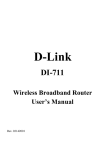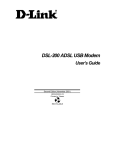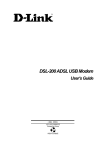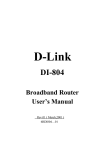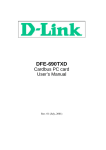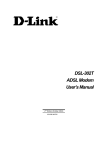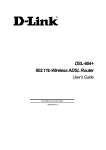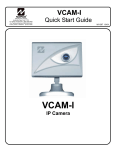Download D-Link DI-713 User`s manual
Transcript
D-Link DI-713P Wireless Broadband Router User’s Manual Contents Contents ........................................................................................................2 Chapter 1 - Getting Started ...........................................................................4 Introduction to Broadband Router Technology........................................6 Introduction to Firewalls ..........................................................................7 Introduction to Local Area Networking ...................................................8 Introduction to Virtual Private Networking..............................................9 Introduction to Wireless Networking .....................................................10 Chapter 2 - Hardware Installation ..............................................................12 Placement ...............................................................................................12 Package Contents....................................................................................12 Front Panel..............................................................................................12 Rear Panel...............................................................................................13 Chapter 3 Basic Broadband Router Configuration .............................14 Start- up and Log in .................................................................................14 Device Information.................................................................................17 Useful Tools............................................................................................18 Setup .......................................................................................................21 Static IP Address ................................................................................22 Dynamic IP Address ...........................................................................23 PPP over Ethernet ...............................................................................24 Dial- up Network .................................................................................27 DHCP .................................................................................................28 Wireless ..............................................................................................30 Print Server .........................................................................................31 Chapter 4 - Advanced Broadband Router Configuration...........................32 2 Virtual Server..........................................................................................34 Special Applications ...............................................................................36 Access Control........................................................................................39 Wireless ..................................................................................................41 Miscellaneous Items ...............................................................................42 DMZ Host...........................................................................................42 Remote Administrator Host................................................................43 Non-Standard FTP Port ......................................................................44 Chapter 5 - Console Mode..........................................................................45 Chapter 6 - Troubleshooting.......................................................................47 Basic Functions ......................................................................................47 LAN Connection Problems ....................................................................49 ISP Connection Problems .......................................................................51 Internet Application Problems................................................................52 Wireless Troubleshooting .......................................................................54 Appendix 1 - Using PING ..........................................................................55 Appendix 2 - Using WINIPCFG ................................................................57 Contacting Technical Support ....................................................................61 Technical Specifications .............................................................................62 D-Link Offices............................................................................................64 Limited Warranty........................................................................................65 Registration Card ........................................................................................73 Rev. 2001-06-21 3 Chapter 1 - Getting Started Thank you for purchasing the D-Link Broadband Router. Your Broadband Router enables you to share your DSL or Cable Internet connection with computers on your wired or wireless network. This guide will explain the features and functions of the Broadband Router to help you get the most out of your Internet experience. D-Link’s Wireless Broadband Router allows wireless LAN users to share a single Internet Connection while providing the safety and security of port blocking, packet filtering, and a natural firewall. Static address support, integrated DHCP, PPPoE, and device name support will allow it to connect to nearly any broadband provider whether Cable or DSL based, and at the same time simplify local area network settings. The Wireless Broadband Router provides two levels of security support. First, it masks local users’ IP addresses from others on the Internet making it much more difficult for a hacker to target a machine on your network. Secondly it can block and redirect certain ports to limit the services that outside users can access. Specific ports can be opened by the user to ensure that games and other Internet applications will run properly. The Wireless Broadband Router provides special pass through support for common VPN implementations. The Virtual Server feature allows you to expose HTTP, FTP, Game Servers and other local services to be accessible to Internet users located outside of the LAN. The User-Definable Application Sensing Tunnel feature allows the user to define the attributes to support special applications requiring multiple connections, such as Internet gaming, video conferencing, and Internet telephony. A DMZ setting can be applied to a single client behind the 4 Wireless Broadband Router to expose it to the Internet and ensure complete Internet application compatibility even if specific ports are not known. Unlike proxy server or NAT software that requires the software server to remain visible on the Internet, no local computers are directly externally visible when using the Wireless Broadband Router. Also the Wireless Broadband Router, like broadband, is always on, removing the need to constantly boot a software server when access is desired from a client. Integrated DHCP services allow up to 252 users to get their IP address automatically on boot up from the Wireless Broadband Router. Client machines require no software, simply set them to accept a dynamically assigned IP address and reboot. Each time they are powered up the Wireless Broadband Router will recognize them and set their IP address to instantly connect them to the LAN 5 Introduction to Broadband Router Technology A router is a device that forwards data packets from a source to a destination. Routers work on OSI layer 3, which forwards data packets using an IP addresses and not a MAC address. A router will forward data from the Internet to a particular computer on your LAN. The information that makes up the Internet gets moved around using routers. When you click on a link on a web page, you send a request to a server to show you the next page. The information that is sent and received from your computer is moved from your computer to the server using routers. A router also determines the best route that your information should follow to ensure that the information is delivered properly. A router controls the amount of data that is sent through your network by eliminating information that shouldn’t be there. This provides security for the computers behind your router because computers from the outside can’t access or send information directly to any computer on your network. The router determines which computer the information should be forwarded to and sends it. If the information isn’t intended for any computer on your network, the data is discarded. This keeps any unwanted or harmful information from accessing or damaging your network. 6 Introduction to Firewalls A firewall is a device that sits between your computer and the Internet that prevents unauthorized access to or from your network. A firewall can be a computer using firewall software or a special piece of hardware built specifically to act as a firewall. In most circumstances, a firewall is used to prevent unauthorized Internet users from accessing private networks such as corporate LAN’s and Intranets. A firewall watches all of the information moving to and from your network and analyzes each piece of data. Each piece of data is checked against a set of criteria that the administrator configures. If any data does not meet the criteria, that data is blocked and discarded. If the data meets the criteria, the data is passed through. This method is called packet filtering. A firewall can also run specific security functions based on the type of application or type of port that is being used. For example, a firewall can be configured to work with an FTP or Telnet server. Or a firewall can be configured to work with specific UDP or TCP ports to allow certain applications or games to work properly over the Internet. 7 Introduction to Local Area Networking Local Area Networking (LAN) is the term used when connecting several computers together over a small area such as a building or group of buildings. LAN’s can be connected over large areas. A collection of LAN’s connected over a large area is called a Wide Area Network (WAN). A LAN consists of multiple computers connected to each other. There are many types of media that can connect computers together. The most common media is CAT5 cable; UTP or STP twisted pair wire. Wireless networks don’t use wires; instead they communicate over radio waves. Each computer must have a Network Interface Card (NIC), which communicates the data between computers. A NIC is usually a 10Mbps network card, 10/100Mbps network card, or a wireless network card. Most networks use hardware devices such as hubs or switches that each cable can be connected to in order to continue the connection between computers. A hub simply takes any data arriving through each port and forwards the data to all other ports. A switch is more sophisticated, in that a switch can determine the port that each piece of data is supposed to be delivered to. A switch minimizes network traffic and speeds up the communication over a network. Networks take some time in order to plan and implement correctly. There are many types of scenarios to consider which could affect the operability of a network. Some of these issues are discussed in this manual under the Networking Basics section. 8 Introduction to Virtual Private Networking Virtual Private Networking (VPN) uses a publicly wired network (the Internet) to connect two different networks as if they were the same network. For example, an employee can access the corporate network from home using VPN, allowing the employee to access files and printers. Here are several different implementations of VPN that can be used. Point-to-Point Tunneling Protocol (PPTP) PPTP uses proprietary means of connecting two private networks over the Internet. PPTP is a way of securing the information that is communicated between networks. PPTP secures information by encrypting the data inside of a packet. IP Security (IPSec) IPSec provides a more secure network-to-network connection across the Internet or a Wide Area Network (WAN). IPSec encrypts all communication between the client and server whereas PPTP only encrypts the data packets. Both of these VPN implementations are used because there is not a standard for VPN server software. Because of this, each ISP or business can implement their own VPN network making interoperability a challenge. 9 Introduction to Wireless Networking D-Link wireless products are based on industry standards to provide easy to use and compatible high speed wireless connectivity within your home or business. Strictly adhering to IEEE 802.11b the D-Link wireless family of products will allow you to access the data you want, when and where you want it. No longer will you be tethered to a workstation or forced to run new wiring. You will be able to enjoy the freedom that wireless networking delivers. Standards Based Technology Based on IEEE 802.11b, D-Link Air products can throughput data up to 11 Megabits per second. This means you will be able to transfer large files quickly or even watch a Movie in MPEG format over your network without noticeable delays. This technology works by using multiple frequencies in the 2.4GHz range utilizing Direct Sequence Spread Spectrum (DSSS) technology. D-Link Air products will automatically sense the best possible connection speed to ensure the greatest speed and range possible with the technology. Installation Considerations Designed to go up to 100 meters indoors and up to 300 meters outdoors, D-Link Air lets you access your network from anywhere you want. Keep in mind, however, that the number of walls, ceilings or other objects that the wireless signals must pass thru will limit range. Typical ranges vary depending on the types of materials and background RF noise in your home or business. The key to maximizing range is to follow these basic principles: 10 1. Keep the number of walls and ceilings to a minimum - Each wall or ceiling can reduce your D-Link Air Wireless products range from 1-30 meters. Position your Access Points, Residential Gateways, and Computers so that the number of walls or ceilings is minimized. 2. Be aware of the direct line between Access Points, Residential Gateways, and Computers - A wall that is .5 meter thick, at a 45 degree angle appears to be almost 1 meter thick. At a 2 degree angle it looks over 14 meters thick! Try to make sure that the AP and Adapters are positioned so that the signal will travel straight through a wall or ceiling for better reception. 3. Building Materials make a difference - A solid metal door or aluminum studs may have a negative effect on range. Again, try to position Access Points, Residential Gateways, and Computers so that the signal passes through drywall or open doorways and not other materials. 4. Make sure that the antenna is positioned for best reception by using the software signal strength tools included with your product. 5. Keep your product away (at least 1-2 meters) from electrical devices that generate RF noise, like microwaves, Monitors, electric motors, etc. For the average American 4-bedroom home, range should not be a problem. If you experience low or no signal strength in areas of your home that you wish to access, consider positioning the Access Point in a location directly between the Residential Gateways and/or Computers that will be connected. Additional Access Points can be connected to provide better coverage in rooms where the signal does not appear as strong as desired. 11 Chapter 2 - Hardware Installation Placement Your Broadband Router should be placed in a safe and secure location. To ensure proper operation, please keep the unit away from water and other damaging elements. Your Broadband Router can be mounted on a wall or a shelf using the screw-holes located on the bottom of the unit. Self-adhesive rubber feet are provided to stick on the bottom of the unit to protect the surface where you have placed the unit. Package Contents The D-Link DI-713P package should include the following items. § DI-713P Broadband router § User’s Manual § Quick Install Guide § Power Adapter § CAT-5 UTP Cable § Print Server Software Front Panel The front panel provides LED’s for device status. Refer to the following table for the meaning of each feature. Power Power status of the DI-713P. A steady LED indicates that the power is on. No LED light indicates lack of power. WLAN Wireless Connection status. The WLAN LED will be ON indicating any wireless connection on the Local Network. WAN Wide Area Network status. When connected to the Internet, the WAN LED should be on. LAN Local Area Network status. A steady LED indicates a 12 STAT connection to the wired local network. A flickering LED indicates data transmission. System status indicator. A flickering light indicates proper operation. Rear Panel The rear panel features a LAN port, WAN port, Serial port and Factory Reset button. Refer to the following table for the meaning of each feature. Serial LPT LAN 1-3 WAN Reset Port used to connect an external analog backup modem. Port used to connect a printer The RJ-45 Ethernet ports used to connect computers with network adapters directly to the DI-713P. The RJ-45 Ethernet port labeled WAN is used to connect your DI-713P to your DSL or Cable modem. Resets the configuration to default settings. 13 Chapter 3 - Basic Broadband Router Configuration Your Broadband Router provides a Web Configuration interface that can be accessed using standard web browsers such as Netscape Communicator or Microsoft Internet Explorer. Since the interface is web based (HTTP), your Broadband Router can be configured with any java and HTML compliant Internet browser in any operating system. This section will discuss the Web Configuration interface and how to use different options and settings. Although you can change the IP address of your Broadband Router to meet your needs, this manual will assume that the defaults are left in place. This means that the IP address of your Broadband Router will be 192.168.0.1. If you have changed the IP address scheme, please substitute 192.168.0.1 with the IP address scheme that you have chosen. Start-up and Log in In order to configure your Broadband Router, you must use your web browser and manually input 192.168.0.1 into the Address box and press Enter. The log in screen will be shown. 14 In order to configure your Broadband Router you must input the administrator password into the System Password box and press the Log in button. The default System Password is admin. Once you have logged-in as administrator, it is a good idea to change the administrator password to insure a secure connection to your Broadband Router. The Tools section described later in this manual describes how to change the password. Once you have input the correct password and logged-in, the screen will change to the Device Information screen. If you are having problems logging in and you are sure that the password you are using is correct, check the top right-hand corner of your keyboard to make sure that the Caps Lock light is not on. Otherwise, refer to Appendix A to reset the password. 15 16 Device Information This screen displays the status of your Internet Connection. The WAN Port Status box shows the Status of your connection to your ISP. If there is no information shown in this section, you will be unable to connect to the Internet. If you have successfully followed the Quick Install guide to setup your Internet Connection, you should see a Renew button. Click the Renew button to renew your connection with your ISP. The Modem Status box displays the status of your dial-up connection while using an external modem. The Firmware Version box shows the current firmware version of your Broadband Router. To upgrade your Broadband Router, visit www.dlink.com and follow the links to download the latest firmware version. The MAC Address field shows the MAC address of your Broadband Router. 17 Useful Tools The Useful Tools screen allows you to change the administrator password, view the system log, reboot your Broadband Router, backup your configuration, clone the MAC address, reset your Broadband Router to original settings, and perform a firmware upgrade. To change the administrator password, click your mouse inside of the Old Password box and type in the old password. Then click inside of the New Password box and type the password that you would like to change to. Next, click inside of the Reconfirm box and type in the new password again. Click OK to save the new password or click the Clear button to remove the passwords you just typed in. To ensure that you use a password that is effective, follow these simple rules: 1. Choose a password that would be hard for someone other than the administrator to guess. 2. Choose a password that is easy for you to remember. 3. Use a combination of letters and numbers. 4. Make sure that the Caps Lock key is not on. 18 The View Log button will display a log of events that has occurred since you last turned on your Broadband Router. Use this to determine problems with your ISP connection. It will show you events where an intruder has tried to access your network, and give you information that can be used to determine if your Broadband Router is functioning correctly. Below is a sample System Log. WAN Type: Dynamic IP Address (2.52 build 6) Display time: 12/13/2000 16:09:59 NOTE! "-00:05:20" means that the event occurred 5 minutes and 20 seconds ago. -01:13:20 DHCP:discover() 259 .$dh:bb1 -12 -01:13:16 DHCP:discover() 259 .$dh:aa1 300 -01:13:16 DHCP:offer(192.177.81.9) -01:13:16 DHCP:request(192.177.81.47) 271 .$dh:aa2 300 -01:13:15 DHCP:ack(DOL=64800,T1=32400,T2=56700) -00:55:18 192.168.0.184 logged out -00:47:38 192.168.0.184 login successful The Reboot button will reboot your Broadband Router. This is helpful when you have changed some settings and need to reboot your Broadband Router but do not want to turn the unit off from the power switch located at the back of your Broadband Router. The Backup Setting button will enable you to save your current settings into a file. This file can be used to restore your settings at a later 19 date. To restore your settings that you have saved, use the Firmware Upgrade button and select the backup file that you saved using the Backup Setting button. Your Broadband Router comes preprogrammed with it’s own Ethernet Address or Media Access Control (MAC) Address. The Clone MAC button will copy the MAC address to match the MAC address of another Ethernet port to ensure an Internet connection with some ISP’s. Contact your ISP to determine if this feature is needed to connect to the Internet. The Restore Defaults button will restore all of the settings you have changed within your Broadband Router Web Configuration Interface to the default settings used when you first purchased the unit. This can be helpful when you want to restore all of the settings to default to ensure that your connection is secure and working properly. When the Firmware Upgrade button is pressed, the following screen will be shown. Click the Browse… button to browse your computer and locate the 20 file that you want to upgrade. Use only files that have been downloaded from the D-Link Support web site to ensure that your Broadband Router is upgraded properly and to ensure proper operation. While upgrading the firmware, DO NOT turn the power off. Turning the unit off while upgrading could render the unit inoperable. Setup This section is crucial to enable your Broadband Router to work with your ISP. The Setup screen will allow you to change the IP address of your Broadband Router, change the WAN type, and allow you to modify the settings that will ensure a proper connection to the Internet. Your ISP should provide most of the settings found in the Setup screen to you. If you followed the Quick Install Guide successfully, these settings should be set and you should be able to access the Internet. If you are not sure which settings should be used, please contact your ISP. The LAN IP Address field is the IP address that your Broadband Router is set to. In most circumstances the LAN IP Address can be left 21 alone, although it can be changed to meet your needs. If you do change the LAN IP Address, be aware that all of your clients will need to be restarted if they are using DHCP or reconfigured to the IP Address scheme that you want to use. For example, if you change the LAN IP Address to 192.168.55.1, you will need to change your clients IP Address’s to a unique number between 192.168.55.2 and 192.168.55.254 in order to ensure proper connection. Refer to the Console Mode section in the Appendix for instructions on how to change the password. Pressing the Change… button next to the WAN Type field will display the Change WAN Type screen shown below. Static IP Address The Static IP Address field should be checked if your ISP assigns you an IP address. This means that your ISP has given you an IP address that you will use to connect to the Internet through their service. 22 Once you have selected Static IP Address, you will be shown the following screen. You will need to input the correct values in each of the WAN fields. Your ISP may have provided each of these values for you. Or, you may have written them down while you followed the Quick Install Guide. After you have input all of the correct values, click Save and reboot your Broadband Router for the changes to take affect. Dynamic IP Address The Dynamic IP Address field should be checked if your ISP has not given you a unique IP address and you receive an automatic IP address each time you connect to your ISP. The rest of the settings related to your connection are retrieved automatically each time you connect to the 23 Internet. Once you have selected Dynamic IP Address, you will be shown the following screen. Some Cable Modem ISP’s such as the @Home network require the Host Name field to be used. If you not sure, contact your ISP to make sure you are inputting the correct values. Enable the Renew IP Forever checkbox if you want your IP address renewed each time it expires even if the system is idle. After you have input all of the correct values, click Save and reboot your Broadband Router for the changes to take affect. PPP over Ethernet The PPP over Ethernet field should be checked if your ISP uses the Point-to-Point over Ethernet protocol to authenticate a username and password and then automatically assign you an IP Address. PPP over Ethernet (PPPoE) is a non-standard method of connecting to your ISP to 24 gain an IP address. It relies upon a software client that is provided by the ISP. If you have a broadband connection and have to login to your provider as you would do with a dial- in modem, then you are probably using PPPoE. If you are simply connected to the Internet when you turn on your computer, you probably are not. The safest way to check is to call your ISP or read the documentation provided when you signed up for your Internet service. Once you have selected PPP over Ethernet, you will be shown the following screen. You will need to input the correct values in each of the blank fields. 25 Your ISP may have provided each of these values for you. Or, you may have written them down while you followed the Quick Install Guide. If you are not sure which settings should be used, please contact your ISP. In the Maximum Idle Time field, input the maximum time that your connection can be used before your ISP disconnects you. If 0.0.0.0 is inputted in the Primary and Secondary DNS fields, these values will be retrieved from your ISP automatically. After you have input all of the correct values, click Save and reboot your Broadband Router for the changes to take affect. 26 Dial-up Network The Dial-up Network field should be used if you use an external modem or PSTN/ISDN. Once you have selected Dial-up Network, you will be shown the following screen. You will need to input the correct values in each of the blank fields. Your ISP may have provided each of these values for you. Or, you may have written them down while you followed the Quick Install Guide. If you are not sure which settings should be used, please contact your ISP. If 27 0.0.0.0 is inputted in the Primary and Secondary DNS fields, these values will be retrieved from your ISP automatically. In the Maximum Idle Time field, input the maximum time that your connection can be used before your ISP disconnects you. Select the correct Baud Rate that your modem is set to. If any extra settings are needed for your external modem to operate correctly, input the correct values in the Extra Settings field. Refer to your modem documentation and your ISP to determine if the Extra Settings field should be used. After you have input all of the correct values, click Save and reboot your Broadband Router for the changes to take affect. DHCP Most networks under the TCP/IP environment include settings for a Host IP, Subnet Mask, Gateway, and DNS configurations. Configuring each computer on the network to use the correct settings can be rather cumbersome. Fortunately, a DHCP Server provides a rather simple approach to handling all of these settings without the headache of configuring each computer. In effect, the DHCP server can provide all of 28 the required information automatically each time a client computer on your network boots up. The DHCP Server screen enables you to configure these settings. You can change whether the DHCP Server is running by choosing Disable or Enable. If you choose Disable, each computer on your network will need to be configured separately in order for them to access the Internet. If Enable is chosen, each computer must be configured to receive an IP Address automatically. Refer to the Quick Install Guide for instructions on how to configure a computer to obtain an IP address automatically. The IP Pool Starting Address is the first IP Address that will be assigned to one of your clients. No address will be lower than this starting address. If you have this set to 100, then no computer on your network will be given an IP address lower than 192.168.0.100. Likewise, the IP Pool Ending Address is the last IP address that the DHCP server will provide. You can also restrict the number of computers that the Broadband Router can support in DHCP by limiting the pool of IP addresses. For example, if you only want 10 IP address’s to be provided to clients on your network, you can set the Starting address to 100 and the Ending address to 109. Doing this will limit the number of clients that can automatically receive an IP address from the Broadband Router. The Domain Name field is optional but can be used to identify your network. Similar to the way Microsoft Windows NT handles the grouping of computers on the same network. 29 Wireless The Wireless Setting screen enables you to change the settings related to your wireless network. This screen is important in configuring your wireless adapters to connect to your Wireless Broadband Router. The Network ID (SSID) field is the name of your network. This field must have the same name that your wireless adapters use in their network settings. The Channel field must also be set to the same settings as your wireless adapter. The Security field enables you to set security keys so that your wireless network is secure. When Enable insecure access is selected, your data is transferred without extra security. This allows your data to be intercepted and examined by intruders. When Security is enabled, your data is more secure. However, network performance is lower because the Wireless Broadband Router must decode each piece of data moving to and 30 from your wireless adapter. The security key that you use must be the same as your wireless adapter. Print Server The DI-713P provides the function of a network print server for Microsoft Window 98, Windows ME, Windows NT and Windows 2000. Please refer to the Print Server Quick Install Guide for installing the port and printer installation. 31 Chapter 4 - Advanced Broadband Router Configuration The default configuration of the Broadband Router will stop most unrecognized information from entering your network. The only IP Address visible to the outside Internet is the IP address of the Broadband Router. Some applications and services require special configuration in order to operate correctly with the Internet. Your Broadband Router provides additional features such as: Virtual Server: Allows services such as e-mail, FTP, or Web hosting servers to operate correctly. It is recommended that separate computers run each service. Special Applications : Allows games and video conferencing applications to operate correctly. Access Control: Allows the definition of access rights and security policies by groups. For example, you may want certain users to have access to the Internet while others cannot. Or you can block certain services such as FTP for certain users. Wireless: Allows wireless network adapters to access the Internet through the Wireless Broadband Router. Miscellaneous Items : Allows the unrestricted, two-way communication for one computer or user on your network, and allows one remote computer to have access to the Broadband Router. 32 To access the Advanced Router Configuration screens, click the Advanced link below. If, at any time, you wish to return to the Basic Configuration screens, click the Basic Link below. 33 Virtual Server In some situations, you may want to provide E-Mail or FTP services from a computer on your network, and you may want those services to be accessible to users outside of your network. The Virtual Server screen allows you to configure specific computers on your network to provide these services to remote users. Each service uses a specific port that is used 34 to communicate over the Internet. All requests to this port will be forwarded to the computer specified in the Server IP field. The Virtual Server screen allows you to configure many different servers. To make configuring the Virtual Server screen easier, the most popular services have been predefined using the Well known services box near the bottom of the screen, as shown below. To use the Well known services box, click on the - select one - box to display a list of popular services. Choose the service you wish to configure by clicking on that service. Next, click the ID box and select the ID row that you wish to configure. Once the service and the ID number are selected, click the Copy to button to copy the settings to the Virtual Server table. Next, you will need to specify the IP Address of the computer that is running the service by typing the IP address in the Server IP box on the same ID row that you configured. After you have configured your Virtual Server settings, click the Save button. The following screen will be shown, telling you to Reboot the Broadband Router for the changes to take effect. 35 Click the Reboot button to reboot the Broadband Router for the changes to take effect. You can also click the Undo button to undo your changes. Note: Only one TCP/IP address can be assigned to each service port. Special Applications Some applications, such as video conferencing software and games that can be played over the Internet, require specific ports to be open to allow communication to and from your network. Due to the firewall function of your Broadband Router, these applications will not work 36 without special settings. The Special Applications screen allows you to specify which ports should be opened and allowed to communicate with computers outside of your network. In situations where some games just won’t work, the DMZ Host settings can be used, which is found in the Misc. Items section. The Trigger field is the initial outbound port number that the application, such as a game, uses to contact a game server. The trigger port will then automatically allow the information to return through the incoming ports. The Incoming Ports field is where you specify the incoming ports that the application uses. Click the box in the Enable column to enable the application. To make configuring the Special Applications screen easier, the most popular applications have been predefined using the Popular applications box near the bottom of the screen, as shown below. To use the Popular applications box, click on the - select one - box to display a list of popular applications. Choose the application you wish to configure by clicking on that application. Next, click the ID box and select the ID row that you wish to configure. Once the application and the ID number are selected, click the Copy to button to copy the settings to the Special Applications table. After you have configured the Special 37 Applications settings, click the Save button. The following screen will be shown telling you to Reboot the Broadband Router for the changes to take effect. Click the Reboot button to reboot the Broadband Router and make the changes take effect. You can also click the Undo button to undo your changes. Note: Only one TCP/IP address can be assigned to each service port. 38 Access Control The Access Control screen allows you to assign different access rights (allow or block) for each group of users. You can divide users into different groups to have similar access rights. To enable access control, click the checkbox next to Enable in the Access Control field. Next, you can define the access control of all users not assigned in groups 1 through 3. For example, you can block all users from using port 21 (FTP) by specifying port 21 in the Default Group field. Next, determine which users need to be blocked or allowed different ports and define them in groups 1, 2, or 3. 39 Tip: You can specify more than one port per group by using dashes (-) and commas (,). For example: 1-10, 20 will block or allow ports 1 through 10, and also 20. Explanation: • Default Group has no right to access Internet (Allow nothing) • Group 1 has 50 members (192.168.0.100 - 192.168.0.149). They can send mail (port 25), receive mail (port 110) and browse the Internet (port 80). Port 53 (DNS) is necessary to resolve the domain name. • Group 2 has 50 members (192.168.0.150 - 192.168.0.199). They can do anything except read net news (port 119) and transfer files via FTP (port 21). • Group 3 has 2 members (192.168.0.10 and 192.168.0.20). They can fully access the Internet (Block nothing) After the Access Control settings have been configured, click the Save button. The following screen will be shown telling you that the 40 changes take effect immediately. Wireless The Wireless Setting screen enables you to change the settings related to your wireless network. This screen is important in configuring your wireless adapters to connect to your Wireless Broadband Router. The Network ID (SSID) field is the name of your network. This field must have the same name that your wireless adapters use in their network settings. The Channel field must also be set to the same settings as your wireless adapter. The Security field enables you to set security keys so that your 41 wireless network is secure. When Enable insecure access is selected, your data is transferred without extra security. This allows your data to be intercepted and examined by intruders. When Security is enabled, your data is more secure. However, network performance is lower because the Wireless Broadband Router must decode each piece of data moving to and from your wireless adapter. The security key that you use must be the same as your wireless adapter. Miscellaneous Items The Miscellaneous Items screen allows you to select one computer as a DMZ Host and to configure one remote computer to be able to access the Broadband Router web configuration. DMZ Host DMZ, or DeMilitarized Zone, means that one computer can have full access to the Internet without the protection of the firewall. This allows a computer to be exposed to unrestricted two-way communication outside of your network. To enable DMZ, type the IP address in the box provided. Then click 42 the checkbox to the right of the IP address. Only one computer can use DMZ at a time. Please note that enabling DMZ removes the protection of the firewall, which exposes the computer to intrusion. Use DMZ only when needed and not for extended periods of time. In some circumstances with gaming, enabling DMZ may help the game contact the maximum number of servers, which can improve ping times. Once the game connects to the game server, disable DMZ to ensure proper firewall protection. Remote Administrator Host In general, only you, or members of your network, should access the web configuration interface of the Broadband Router. In some circumstances though, you may want to have access to the Broadband Router web interface to change settings while you are away from your network. The Remote Administrator Host field allows you to input the IP address of one remote computer so that it can access the web configuration interface to perform administrative tasks. Note: If you specify an IP address of 0.0.0.0 and enable Remote Administration, any computer can connect to the Broadband Router from outside of your network. Also, when this feature is enabled, the web port will be shifted to port 88. This is a security precaution to prevent an indiscriminate port scan, which could find the web configuration interface and hack into your connection. In order for the remote administrator to access the web configuration interface, the user must input the IP address that has been given to the WAN port of the Broadband Router (found in the Device Information screen). For example: HTTP://192.168.51.23:88 43 Non-Standard FTP Port Some FTP servers use a different port number than the standard port 21. This field will allow you to specify a non-standard FTP port number for compatibility with those FTP servers. After you have configured the Miscellaneous Items settings, click the Save button. The following screen will be shown telling you that the settings have been saved, but some items may not take effect until the Broadband Router is rebooted. Click the Reboot button to reboot the Broadband Router for make the changes to take effect. You can also click the Undo button to undo your changes. 44 Chapter 5 - Console Mode In some situations, you may need to access your Broadband Router from the serial port interface known as the Console Mode. Console Mode allows you to change the IP address, and password, toggle the DHCP server setting, and restore default settings to your Broadband Router. You may use the HyperTerminal program provided with Microsoft Windows to access the Console Mode. A null modem cable is required to connect the COM port of your computer to the COM port of the Broadband Router. When connecting the null modem cable to your computer, make a note of which COM port you use, you will need this information when you setup the connection in HyperTerminal. To use the Console Mode, follow these steps: 1. Connect the null modem cable from your Broadband Router’s COM port to your computers COM port. 2. Open HyperTerminal by clicking on Start>Programs>Accessories>Communications>HyperTerminal. 3. Setup a terminal connection using the following settings: Bits per second (baud): Data bits: Parity: Stop bits: Flow control: 19200 8 None 1 Hardware 4. Start the connection and turn the Broadband Router off and then on again. When the Broadband Router finishes the startup tests, press the ENTER key several times on your keyboard. 45 The following screen will be shown: Firmware Version = 2.51 build 9 Command List: IP (set device IP; e.g. IP 192.168.123.254) PW (set new PassWord; e.g. PW admin) DS (toggle Dhcp Server setting) SR (Save new setting and Reboot) RR (Restore default setting and Reboot) Current Setting: Device IP = 192.168.0.1 DHCP Server = Enable > If the command list screen doesn’t show, start this step over again and watch the LED’s on the Broadband Router closely so that you press the ENTER key at the correct time. 5. The command list shows the commands that you can use. The Current Settings portion shows the current configuration. Type the command and press the ENTER key to execute that command. For example: if you wanted to change the IP address and the Password from the current setting to IP address “192.168.200.210” and the password to “john”, you would type the following: IP 192.168.200.210 (hit ENTER) PW john (hit ENTER) And then to save the settings and restart the Broadband Router, type SR and hit ENTER. 46 Chapter 6 - Troubleshooting In the event that you are unable to connect to or use your Broadband Router, please refer to the following troubleshooting guide. After each problem description, a possible cause and problem resolution is provided. If this section does not help you fix the problem, go to the D-Link web site (www.dlink.com) for additional troubleshooting tips. If neither of these helps, please contact D-Link Technical Support for additional help. The phone numbers for Technical Support are in the appendix of this manual under D-Link Offices. Basic Functions My Broadband Router will not turn on. No LED’s light up. Cause: § The power is not connected or the power switch is set to “Off”. Resolution: § Connect the power adapter to your Broadband Router and plug it into the power outlet. § Make sure that the power switch is set to “On”. Note: Only use the power adapter provided with your Broadband Router. Using any other adapter may damage your Broadband Router. LED’s don’t follow the correct boot-up sequence. Cause: § The unit has a corrupt firmware. § The unit is not receiving the correct voltage from the power supply. 47 Resolution: § Download and upgrade the latest firmware. § Make sure the correct firmware has been used while upgrading. Use only the firmware provided on D-Link’s web or FTP sites. § Use only the power adapter provided. The Link or Act LED’s do not turn on. Cause: § The network cable is not connected. § The network cable is connected but not the right type, whether it be patch or straight-through. Resolution: § Make sure that both ends of the cable are connected. § Try using another cable. § If you are using a straight-through cable, try a patch cable and vice-versa. Sometimes my Broadband Router stops working or locks up. Cause: § Someone has attempted to hack into someone on your LAN. § The Broadband Router has detected harmful data trying to access your LAN. § The NAT table is full. Resolution: § Reboot the Broadband Router by turning the power to the unit off and then on again. Some types of hacker tools use very non-standard data streams. Some of these streams may cause the Broadband Router to 48 lock up. When the Broadband Router locks up, it will not affect the computers attached to it. You may need to restart the client computers to regain Internet access. Although sometimes inconvenient, a lock-up is an indication of an attack. Part of the design of the Broadband Router is to act as a decoy for such traffic. If your computer locked up instead you may have lost changes to open files, lost data, or corrupted your operating system or hard drive. If you are currently experiencing frequent lock-ups, you may wish to upgrade the firmware. LAN Connection Problems I can’t access my Broadband Router. Cause: § The unit is not turned on. § There is not a network connection. § The computer you are using does not have a compatible IP Address. Resolution: § Make sure your Broadband Router is turned on. § Make sure that there is a physical connection between your computer and the Broadband Router and that the Link light is on. § Use the WINIPCFG utility described in the appendix to make sure that your computer has a compatible IP Address. If your IP Address is not set correctly and you are using DHCP, use WINIPCFG to renew your IP Address. Otherwise, make correct changes to your Windows network settings. Make sure that the IP Address used on your computer 49 § § is set to the same subnet as the Broadband Router. For example, if the Broadband Router is set to 192.168.0.1, change the IP address of your computer to 192.168.0.15 or another unique IP Address that corresponds to the 192.168.0.X subnet. Follow the instructions outlined in the Appendix section labeled “Console Mode” to check the basic settings of your Broadband Router. You can verify the IP Address of the Broadband Router to make sure that your computers IP Address are set correctly. Use the Reset button located on the front of your Broadband Router to revert to the default settings. I can’t connect to other computers on my LAN. Cause: § The IP Addresses of the computers are not set correctly. § Network cables are not connected properly. § Windows network settings are not set correctly. Resolution: § Make sure that each computer has a unique IP Address. If using DHCP through the Broadband Router, make sure that each computer is set to “Obtain an IP Address automatically” and restart the computer. Use the WINIPCFG and PING utilities described in the appendix to make sure that you can connect to each computer. § Make sure that the Link LED is on. If it is not, try a different network cable. § Check each computer for correct network settings. Refer to the Network basics section in this manual for instructions on how to share resources. 50 ISP Connection Problems I can access the Broadband Router, but I can’t connect to my ISP. Cause: § Your DSL or Cable modem is not functioning correctly. § The cable is connected from the WAN port of the Broadband Router to your DSL or Cable modem. § The wrong connection type is used in Setup. § The username and password is not input correctly. § If using @Home service, the computer name is not input correctly. § Your ISP may only allow one MAC address to access the Internet. § You ISP may only allow one computer to access their service. Resolution: § Make sure that your DSL or Cable modem is running correctly and connected to the WAN port of the Broadband Router. § Make sure that the right connection type is used in the web configuration. § Make sure that the username and password used in the connection type is correct. § If using @Home, make sure that the computer name is input correctly. § Clone the MAC address using the web configuration interface. § Some ISP's do not care if you share your broadband connection among multiple users. Other ISP's will explicitly restrict this type of activity in your service contract. It is important that you verify that you are in accordance with your service agreement before sharing Internet access. 51 Internet Application Problems My online game does not work. Cause: § The NAT table has filled up. § The correct settings have not been used to open the correct ports for your application. § The unit has stopped working or crashed. Resolution: § If you are trying to connect to game servers and your connection has stopped working, wait a few minutes or turn the unit off and then on again. Games send out many requests to many different servers trying to find the best game server for your connection. When this is done, the NAT table used in the Broadband Router can fill up and stop working temporarily. Try using the DMZ host feature while connecting to game servers and then disabling DMZ while playing the game. § Turn the Broadband Router off and then on again to reset the NAT table. § Make sure that the correct ports have been opened in order for your specific game to operate correctly behind a firewall. Consult your game documentation or contact technical support for your game to obtain the correct settings for your game. § Some games just won’t operate correctly behind a firewall. In this case, use the DMZ host feature while using the game, then turning DMZ off while the game is not being played to ensure proper firewall protection. 52 My E-Mail program doesn’t receive my E-Mail Cause: § The Domain Suffix is not set correctly. Resolution: § Some email applications require you to enter the Domain Suffix when you configure your network and TCP/IP settings. The Domain Suffix is the unique identifier for your email server. The Domain Suffix is the Internet Protocol (TCP/IP) address of the email server you are using. Your cable modem or DSL provider usually lists it somewhere on your invoice. The Domain Suffix address should appear similar to this: dlink.occa.home.com. Find the Domain Suffix on your invoice or call your Internet Service Provider (ISP) to obtain it. Can’t connect to AOL Cause: § Your AOL software is not set correctly to use the Broadband Router. Resolution: § Use your AOL software to change the location information to use TCP/IP in the Network field. Leave the phone number blank. Save your settings and try to sign on again. If this does not help, make sure that you can access the Internet in general. If you can access the Internet, contact AOL technical support to help you configure your AOL software to work correctly with your Broadband Router. 53 Wireless Troubleshooting Can’t access the Broadband Router from a wireless network card Cause: § Settings are not the same among each wireless adapter. § Out of range. § IP Address is not set correctly. Resolution: § Make sure that the Mode, SSID, Channel and encryption settings are set the same on each wireless adapter. The default SSID and Channel that the Wireless Broadband Router uses is “default” and “6” respectively. § Make sure that your computer is within range and free from any strong electrical devices that may cause interference. Refer to the section “Introduction to Wireless Networking” for tips to help make a good connection. § Check your IP Address to make sure that it is compatible with the Wireless Broadband Router. The default IP Address of the Wireless Broadband Router is “192.168.0.1”. A compatible IP Address would be “192.168.0.50”. 54 Appendix 1 - Using PING In Windows, Microsoft has provided a small utility called PING that can be used to troubleshoot your IP address and connection. The PING utility is used mainly to test the connection between your computer and a client computer. Using the PING utility to check a connection can be helpful in determining where the problem is, whether it be your Broadband Router, your DSL or Cable modem, or your ISP. Use the following steps to use the WINIPCFG utility: § Click on the Start button and click Run. § Type "command" in the Open box. § Click "OK" to get to a DOS prompt. § Type "ping 192.168.0.1", which is the IP address of the Gateway in this case, and hit the Enter key. The following screen will be shown. C:\>ping 192.168.0.1 Pinging 192.168.0.1 with 32 bytes of data: Reply from 192.168.0.1: bytes=32 time=130ms TTL=64 Reply from 192.168.0.1: bytes=32 time=10ms TTL=64 Reply from 192.168.0.1: bytes=32 time=20ms TTL=64 Reply from 192.168.0.1: bytes=32 time=10ms TTL=64 Ping statistics for 192.168.0.1: Packets: Sent = 4, Received = 4, Lost = 0 (0% loss), Approximate round trip times in milli-seconds: Minimum = 10ms, Maximum = 130ms, Average = 42ms This screen shows a successful connection between you and your Broadband Router. You can use these same steps to ping your DSL or Cable modem and then your ISP provider and Internet 55 § website. If any one of these attempts results in an unsuccessful PING, your connection is not complete. If a PING is unsuccessful between you and your DSL or Cable modem, then your connection is not setup correctly. If it is unsuccessful when PINGing your ISP or an Internet site, then your connection is setup correctly but there is a problem with your ISP or the Internet site you tried to PING is unavailable. The screen shown below is an example of an unsuccessful PING. C:\>ping 192.168.0.1 Pinging 192.168.0.1 with 32 bytes of data: Request timed out. Request timed out. Request timed out. Request timed out. Ping statistics for 192.168.0.1: Packets: Sent = 4, Received = 0, Lost = 4 (100% loss), Approximate round trip times in milli-seconds: Minimum = 0ms, Maximum = 0ms, Average = 0ms 56 Appendix 2 - Using WINIPCFG In Microsoft Windows versions 95 through Me, Microsoft has provided a small utility called WINIPCFG that can be used to troubleshoot your IP address and connection. The WINIPCFG utility is used mainly to view, release and renew your IP Address configuration. Windows NT (including Windows 2000) has a similar utility called IPCONFIG that can be used to perform similar tasks. Use the following steps to use the WINIPCFG utility: § Click on the Start button and click Run § Type "winipcfg" in the Open box. § Click OK. The IP Configuration screen will be displayed. The IP address will be displayed in the IP Address box. If you have more than one network card, make sure that the network card that you are using is displayed in the white dropdown box. Make sure that the Default Gateway is the IP Address of your Broadband Router. If it is not, you will not be able to connect to the 57 Internet. If you are using DHCP, click the Release and then the Renew buttons to receive the correct settings. If you manually set your network settings, make sure that the IP Address of your Broadband Router is set in the Gateway portion of the TCP/IP settings in your network settings. § Click on "More Info" to display additional IP information. The important settings to watch for in this screen are in the Host Information box. Make sure that the DNS Servers box has the 58 correct DNS information. Also check the DHCP server box to make sure that you are connected to the right DHCP server. 59 60 Contacting Technical Support D-Link provides free technical support for customers within the United States. U.S. customers can contact D-Link technical support through our web site, e-mail, or by phone. United States technical support is available Monday through Friday from 6:00 a.m. to 6:00 p.m. (PST). Web: http://www.dlink.com Email: support@dlink.com Phone: 949-788-0805 (option #4) If you are a customer residing outside of the United States, please refer to the list of D-Link locations that is included in this manual. Thank you for purchasing this product. We like to receive feedback from our customers concerning our products. Please take a moment to visit our web site. You can register your purchase on-line, learn more about the newest networking products, and let us know the things your new network has empowered you to do. 61 Technical Specifications Standards: • IEEE 802.3 10BASE-T Ethernet • IEEE 802.3u 100BASE-TX Fast Ethernet • ANSI/IEEE 802.3 NWay auto-negotiation Protocols Supported: • TCP • IP • NAT • UDP • PPPoE • DHCP (Client and Server) Management: • Web-Based Ports: • LAN: NWay 10BASE-T/100BASE-TX Fast Ethernet • WAN: 10BASE-T • RS-232 (DB-9) Serial Additional details available at D-Link’s web site (www.dlink.com). 62 Wireless Specifications General Wireless Specifications: • IEEE 802.11b Wireless LAN, Wi-Fi Compatible Access Point Frequency Band: • 2.4 ~ 2.4835 GHz (subject to local regulation) Access Point Number of Channel: • USA & Canada: 11 Access Point Frequency Range: • 5 Mbps Access Point Data Rate: • 11 Mbps • 5.5 Mbps • 2 Mbps • 1 Mbps 63 D-Link Offices AUSTRALIA CANADA CHILE CHINA DENMARK EGYPT FRANCE GERMANY INDIA ITALY JAPAN RUSSIA SINGAPORE S. AFRICA SWEDEN TAIWAN U.K. U.S.A. D-LINK AUSTRALASIA Unit 16, 390 Eastern Valley Way, Roseville, NSW 2069, Australia TEL: 61-2-9417-7100 FAX: 61-2-9417-1077 TOLL FREE: 1800-177-100 (Australia), 0800-900900 (New Zealand) URL: www.dlink.com.au E-MAIL: support@dlink.com.au, info@dlink.com.au D-LINK CANADA 2180 Winston Park Drive, Oakville, Ontario L6H 5W1 Canada TEL: 1-905-829-5033 FAX: 1-905-829-5095 BBS: 1-965-279-8732 FREE CALL: 1-800-354-6522 URL: www.dlink.ca E-MAIL: techsup@dlink.ca D-LINK SOUTH AMERICA Isidora Goyenechea #2934 of.702, Las Condes, Santiago, Chile TEL: 56-2-232-3185 FAX: 56-2-2320923 URL: www.dlink.cl D-LINK CHINA 2F., Sigma Building, 49 Zhichun Road, Haidian District, 100080 Beijing, China TEL: 86-10-88097777 FAX: 86-10-88096789 URL: www.dlink.com.cn D-LINK DENMARK Naverland 2, DK-2600 Glostrup, Copenhagen, Denmark TEL:45-43-969040 FAX:45-43-424347 URL: www.dlink.dk E-MAIL: info@dlink.dk D-LINK MIDDLE EAST 7 Assem Ebn Sabet Street, Heliopolis Cairo, Egypt TEL: 202-2456176 FAX: 202-2456192 URL: www.dlink-me.com E-MAIL: support@dlink-me.com D-LINK FRANCE Le Florilege #2, Allee de la Fresnerie 78330 Fontenay Le Fleury France TEL: 33-1-30238688 FAX: 33-1-3023-8689 URL: www.dlink-france.fr E-MAIL: info@dlink-france.fr D-LINK GERMANY Bachstrae 22, D-65830 Kriftel Germany TEL: 49-(0)6192-97110 FAX: 49-(0)6192-9711-11 URL: www.dlink.de BBS: 49-(0)6192-971199 (Analog) 49-(0)6192-971198 (ISDN) INFO LINE: 00800-7250-0000 (toll free) HELP LINE: 00800-7250-4000 (toll free) REPAIR LINE: 00800-7250-8000 D-LINK INDIA Plot No.5, Kurla -Bandra Complex Road, Off Cst Road, Santacruz (E), Bombay - 400 098 India TEL: 91-22-652-6696 FAX: 91-22-652-8914 URL: www.dlink-india.com E-MAIL: service@dlink.india.com D-LINK ITALIA Via Nino Bonnet No. 6/b, 20154 Milano, Italy TEL: 39-02-2900-0676 FAX: 39-02-2900-1723 URL: www.dlink.it E-MAIL: info@dlink.it D-LINK JAPAN 10F, 8-8-15 Nishi-Gotanda, Shinagawa-ku, Tokyo 141 Japan TEL: 81-3-5434-9678 FAX: 81-3-5434-9868 URL: www.d-link.co.jp D-LINK RUSSIA Michurinski Prospekt 49, 117607 Moscow, Russia TEL: 7-095-737-3389, 7-095-737-3492 FAX: 7-095-737-3390 D-LINK INTERNATIONAL 1 International Business Park, #03-12 The Synergy, Singapore 609917 TEL: 65-774-6233 FAX: 65-774-6322 URL: www.dlink-intl.com E-MAIL: info@dlink.com.sg D-LINK SOUTH AFRICA Unit 2, Parkside 86 Oak Avenue Highveld Technopark Centurion, Gauteng, Republic of South Africa TEL: 27(0)126652165 FAX: 27(0)126652186 D-LINK SWEDEN P.O. Box 15036, S-167 15 Bromma Sweden TEL: 46-(0)8564-61900 FAX: 46-(0)8564-6 1 9 0 1 E-MAIL: info@dlink.se URL: www.dlink.se D-LINK TAIWAN 2F, No. 119 Pao-Chung Road, Hsin-Tien, Taipei, Taiwan, R.O.C. TEL: 886-2-2910-2626 FAX: 886-2-2910-1515 URL: www.dlinktw.com.tw D-LINK EUROPE 4 th Floor, Merit House, Edgware Road, Colindale, London, NW9 5AB, U.K. TEL: 44-20-8731-5555 FAX: 44-20-8731-5511 URL: www.dlink.co.uk E-MAIL: info@dlink.co.uk D-LINK U.S.A. 53 Discovery Drive, Irvine, CA 92618 USA TEL: 1-949-788-0805 FAX: 1-949-753-7033 INFO LINE: 1-800-326-1688 BBS: 1-949-455-1779, 1-949-455-9616 URL: www.dlink.com E-MAIL: tech@dlink.com, support@dlink.com Tech Support Hours: 6 A.M. to 6 P.M. Pacific Standard Time. Monday through Friday 64 Limited Warranty D-Link Systems, Inc. (“D-Link”) provides this limited warranty for its product only to the person or entity who originally purchased the product from D-Link or its authorized reseller or distributor. Limited Hardware Warranty: D-Link warrants that the hardware portion of the D-Link products described below (“Hardware”) will be free from material defects in workmanship and materials from the date of original retail purchase of the Hardware, for the period set forth below applicable to the product type (“Warranty Period”) if the Hardware is used and serviced in accordance with applicable documentation; provided that a completed Registration Card is returned to an Authorized D-Link Service Office within ninety (90) days after the date of original retail purchase of the Hardware. If a completed Registration Card is not received by an authorized D-Link Service Office within such ninety (90) day period, then the Warranty Period shall be ninety (90) days from the date of purchase. Product Type Warranty Period Product (excluding power supplies and fans), if One (1) Year purchased and delivered in the fifty (50) United States, or the District of Columbia (“USA”) Product purchased or delivered outside the USA One (1) Year Power Supplies and Fans One (1) Year Spare parts and spare kits Ninety (90) days D-Link’s sole obligation shall be to repair or replace the defective Hardware at no charge to the original owner. Such repair or replacement will be rendered by D-Link at an Authorized D-Link Service Office. The replacement Hardware need not be new or of an identical make, model or part; D-Link may in its discretion may replace the defective Hardware (or 65 any part thereof) with any reconditioned product that D-Link reasonably determines is substantially equivalent (or superior) in all material respects to the defective Hardware. The Warranty Period shall extend for an additional ninety (90) days after any repaired or replaced Hardware is delivered. If a material defect is incapable of correction, or if D-Link determines in its sole discretion that it is not practical to repair or replace the defective Hardware, the price paid by the original purchaser for the defective Hardware will be refunded by D-Link upon return to D-Link of the defective Hardware. All Hardware (or part thereof) that is replaced by D-Link, or for which the purchase price is refunded, shall become the property of D-Link upon replacement or refund. Limited Software Warranty: D-Link warrants that the software portion of the product (“Software”) will substantially conform to D-Link’s then current functional specifications for the Software, as set forth in the applicable documentation, from the date of original delivery of the Software for a period of ninety (90) days (“Warranty Period”), if the Software is properly installed on approved hardware and operated as contemplated in its documentation. D-Link further warrants that, during the Warranty Period, the magnetic media on which D-Link delivers the Software will be free of physical defects. D-Link’s sole obligation shall be to replace the non-conforming Software (or defective media) with software that substantially conforms to D-Link’s functional specifications for the Software. Except as otherwise agreed by D-Link in writing, the replacement Software is provided only to the original licensee, and is subject to the terms and conditions of the license granted by D-Link for the Software. The Warranty Period shall extend for an additional ninety (90) 66 days after any replacement Software is delivered. If a material non-conformance is incapable of correction, or if D-Link determines in its sole discretion that it is not practical to replace the non-conforming Software, the price paid by the original licensee for the non-conforming Software will be refunded by D-Link; provided that the non-conforming Software (and all copies thereof) is first returned to D-Link. The license granted respecting any Software for which a refund is given automatically terminates. What You Must Do For Warranty Service: Registration Card. The Registration Card provided at the back of this manual must be completed and returned to an Authorized D-Link Service Office for each D-Link product within ninety (90) days after the product is purchased and/or licensed. The addresses/telephone/fax list of the nearest Authorized D-Link Service Office is provided in the back of this manual. FAILURE TO PROPERLY COMPLETE AND TIMELY RETURN THE REGISTRATION CARD MAY AFFECT THE WARRANTY FOR THIS PRODUCT. Submitting A Claim. Any claim under this limited warranty must be submitted in writing before the end of the Warranty Period to an Authorized D-Link Service Office. The claim must include a written description of the Hardware defect or Software nonconformance in sufficient detail to allow D-Link to confirm the same. The original product owner must obtain a Return Material Authorization (RMA) number from the Authorized D-Link Service Office and, if requested, provide written proof of purchase of the product (such as a copy of the dated purchase invoice for the product) before the warranty service is provided. After an 67 RMA number is issued, the defective product must be packaged securely in the original or other suitable shipping package to ensure that it will not be damaged in transit, and the RMA number must be prominently marked on the outside of the package. The packaged product shall be insured and shipped to D-Link, 53 Discovery Drive, Irvine CA 92618, with all shipping costs prepaid. D-Link may reject or return any product that is not packaged and shipped in strict compliance with the foregoing requirements, or for which an RMA number is not visible from the outside of the package. The product owner agrees to pay D-Link’s reasonable handling and return shipping charges for any product that is not packaged and shipped in accordance with the foregoing requirements, or that is determined by D-Link not to be defective or non-conforming. What Is Not Covered: This limited warranty provided by D-Link does not cover: Products that have been subjected to abuse, accident, alteration, modification, tampering, negligence, misuse, faulty installation, lack of reasonable care, repair or service in any way that is not contemplated in the documentation for the product, or if the model or serial number has been altered, tampered with, defaced or removed; Initial installation, installation and removal of the product for repair, and shipping costs; Operational adjustments covered in the operating manual for the product, and normal maintenance; Damage that occurs in shipment, due to act of God, failures due to power surge, and cosmetic damage; and Any hardware, software, firmware or other products or services provided 68 by anyone other than D-Link. Disclaimer of Other Warranties: EXCEPT FOR THE LIMITED WARRANTY SPECIFIED HEREIN, THE PRODUCT IS PROVIDED “AS-IS” WITHOUT ANY WARRANTY OF ANY KIND INCLUDING, WITHOUT LIMITATION, ANY WARRANTY OF MERCHANTABILITY, FITNESS FOR A PARTICULAR PURPOSE AND NON-INFRINGEMENT. IF ANY IMPLIED WARRANTY CANNOT BE DISCLAIMED IN ANY TERRITORY WHERE A PRODUCT IS SOLD, THE DURATION OF SUCH IMPLIED WARRANTY SHALL BE LIMITED TO NINETY (90) DAYS. EXCEPT AS EXPRESSLY COVERED UNDER THE LIMITED WARRANTY PROVIDED HEREIN, THE ENTIRE RISK AS TO THE QUALITY, SELECTION AND PERFORMANCE OF THE PRODUCT IS WITH THE PURCHASER OF THE PRODUCT. Limitation of Liability: TO THE MAXIMUM EXTENT PERMITTED BY LAW, D-LINK IS NOT LIABLE UNDER ANY CONTRACT, NEGLIGENCE, STRICT LIABILITY OR OTHER LEGAL OR EQUITABLE THEORY FOR ANY LOSS OF USE OF THE PRODUCT, INCONVENIENCE OR DAMAGES OF ANY CHARACTER, WHETHER DIRECT, SPECIAL, INCIDENTAL OR CONSEQUENTIAL (INCLUDING, BUT NOT LIMITED TO, DAMAGES FOR LOSS OF GOODWILL, WORK STOPPAGE, COMPUTER FAILURE OR MALFUNCTION, LOSS OF INFORMATION OR DATA CONTAINED IN, STORED ON, OR INTEGRATED WITH ANY PRODUCT RETURNED TO D-LINK FOR WARRANTY SERVICE) RESULTING 69 FROM THE USE OF THE PRODUCT, RELATING TO WARRANTY SERVICE, OR ARISING OUT OF ANY BREACH OF THIS LIMITED WARRANTY, EVEN IF D-LINK HAS BEEN ADVISED OF THE POSSIBILITY OF SUCH DAMAGES. THE SOLE REMEDY FOR A BREACH OF THE FOREGOING LIMITED WARRANTY IS REPAIR, REPLACEMENT OR REFUND OF THE DEFECTIVE OR NON-CONFORMING PRODUCT. GOVERNING LAW: This Limited Warranty shall be governed by the laws of the state of California. Some states do not allow exclusion or limitation of incidental or consequential damages, or limitations on how long an implied warranty lasts, so the foregoing limitations and exclusions may not apply. This limited warranty provides specific legal rights and the product owner may also have other rights which vary from state to state. Trademarks Copyright 1999 D-Link Corporation. Contents subject to change without prior notice. D-Link is a registered trademark of D-Link Corporation/D-Link Systems, Inc. All other trademarks belong to their respective proprietors. Copyright Statement No part of this publication may be reproduced in any form or by any means or used to make any derivative such as translation, transformation, or adaptation without permission from D-Link Corporation/D-Link Systems Inc., as stipulated by the United States Copyright Act of 1976. 70 CE Mark Warning This is a Class B product. In a domestic environment, this product may cause radio interference, in which case the user may be required to take adequate measures Warnung! Dies ist in Produkt der Klasse B. Im Wohnbereich kann dieses Produkt Funkstoerungen verursachen. In diesem Fall kann vom Benutzer verlangt werden, angemessene Massnahmen zu ergreifen. Advertencia de Marca de la CE Este es un producto de Clase B. En un entorno doméstico, puede causar interferencias de radio, en cuyo case, puede requerirse al usuario para que adopte las medidas adecuadas. Attention! Ceci est un produit de classe B. Dans un environnement domestique, ce produit pourrait causer des interférences radio, auquel cas l`utilisateur devrait prendre les mesures adéquates. Attenzione! Il presente prodotto appartiene alla classe B. Se utilizzato in ambiente domestico il prodotto può causare interferenze radio, nel cui caso è possibile che l`utente debba assumere provvedimenti adeguati. FCC Warning This equipment has been tested and found to comply with the limits for a 71 Class B digital device, pursuant to part 15 of the FCC Rules. These limits are designed to provide reasonable protection against harmful interference in a residential installation. This equipment generates, uses and can radiate radio frequency energy and, if not installed and used in accordance with the instructions, may cause harmful interference to radio communications. However, there is no guarantee that interference will not occur in a particular installation. If this equipment does cause harmful interference to radio or television reception, which can be determined by turning the equipment off and on, the user is encouraged to try to correct the interference by one or more of the following measures: -Reorient or relocate the receiving antenna. -Increase the separation between the equipment and receiver. -Connect the equipment into an outlet on a circuit different from that to which the receiver is connected. -Consult the dealer or an experienced radio/ TV technician for help. VCCI Warning 72 Register by mail or online at http://www.dlink.com/sales/reg/ Registration Card Print, type or use block letters. Your name: Mr./Ms _____________________________________________________________________________ Organization: ________________________________________________ Dept. ____________________________ Your title at organization: ________________________________________________________________________ Telephone: _______________________________________ Fax:________________________________________ Organization's full address: ______________________________________________________________________ ____________________________________________________________________________________________ Country: _____________________________________________________________________________________ Date of purchase (Month/Day/Year): _______________________________________________________________ Product Model Product Serial No. * Product installed in type of computer (e.g., Compaq 486) * Product installed in computer serial No. (* Applies to adapters only) Product was purchased from: Reseller's name: ______________________________________________________________________________ Telephone: _______________________________________ Fax:________________________________________ Reseller's full address: _________________________________________________________________________ _________________________________________________________________________ _________________________________________________________________________ Answers to the following questions help us to support your product: 1. Where and how will the product primarily be used? oHome oOffice oTravel oCompany Business oHome Business oPersonal Use 2. How many employees work at installation site? o1 employee o2-9 o10-49 o50-99 o100-499 o500-999 o1000 or more 3. What network protocol(s) does your organization use? oXNS/IPX oTCP/IP oDECnet oOthers_____________________________ 4. What network operating system(s) does your organization use? oD-Link LANsmart oNovell NetWare oNetWare Lite oSCO Unix/Xenix oPC NFS o3Com 3+Open oBanyan Vines oDECnet Pathwork oWindows NT oWindows NTAS oWindows '95 oOthers__________________________________________ 5. What network management program does your organization use? oD-View oHP OpenView/Windows oHP OpenView/Unix oSunNet Manager oNovell NMS oNetView 6000 oOthers________________________________________ 6. What network medium/media does your organization use ? oFiber-optics oThick coax Ethernet oThin coax Ethernet o10BASE-T UTP/STP o100BASE-TX o100BASE-T4 o100VGAnyLAN oOthers_________________ 7. What applications are used on your network? oDesktop publishing oSpreadsheet oWord processing oCAD/CAM oDatabase management oAccounting oOthers_____________________ 8. What category best describes your company? oAerospace oEngineering oEducation oFinance oHospital oLegal oInsurance/Real Estate oManufacturing oRetail/Chainstore/Wholesale oGovernment oTransportation/Utilities/Communication oVAR oSystem house/company oOther________________________________ 9. Would you recommend your D-Link product to a friend? oYes oNo oDon't know yet 10.Your comments regarding this product? __________________________________________________________________________________________ __________________________________________________________________________________________ 73 74











































































